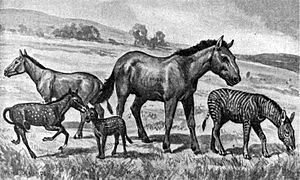Equidae facts for kids
Quick facts for kids Equids |
|
|---|---|
 |
|
| Plains Zebras | |
| Scientific classification | |
| Kingdom: | |
| Phylum: | |
| Class: | |
| Order: | |
| Family: |
Equidae
Gray, 1821
|
| Genus: |
Equus
Linnaeus, 1758
|
Equids are a group of mammals that belong to a special family called Equidae. These animals are known for having an odd number of toes, like horses, donkeys, and zebras. Today, there is only one group of living equids, called Equus.
Animals in the Equus group can sometimes have babies with different types of equids. These babies are called hybrids, but they usually cannot have their own babies when they grow up. Equids can also have many different colors!
How Equids Evolved Over Time

The oldest known fossils of equids are about 54 million years old. They were found from a time called the early Eocene period. These early equids were small, about the size of a fox. They had three toes on their back feet and four toes on their front feet.
These ancient equids ate soft plants. They were already good at running, which helped them escape from danger. Their brains were quite complex, suggesting they were smart and aware animals. Over millions of years, equids slowly changed. They started to have fewer toes. Their teeth also became stronger, which helped them grind up tough grasses and other plants.
During the Miocene period, which was millions of years later, the equid family became very diverse. Many new species appeared. By this time, equids looked much more like the horses we know today. Most of their body weight rested on their middle toe. Their other toes became much smaller and barely touched the ground. The only group of equids that survived until today, Equus, appeared in the early Pleistocene period. These modern equids quickly spread all over the world.
Images for kids
-
Equus (Przewalski's horse)
See also
 In Spanish: Équidos para niños
In Spanish: Équidos para niños





